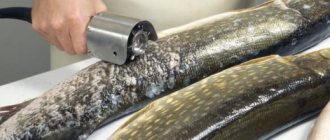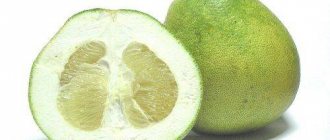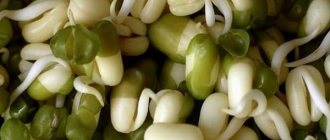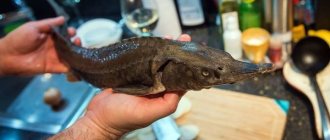Tench belongs to the class of river and lake fish of the carp family. It most likely got its name from its ability to change color: in air or in a shallow container with a small amount of water, dark spots appear on its thick, clumsy body - it begins to “molt.” Lives for a long time, sometimes more than 15 years: due to its passive lifestyle and habitat (at the bottom), it rarely becomes a victim of predators. An adult can reach large sizes: about 6-7 kg in weight and more than 50 cm in length.
Taste and nutritional qualities
Tench has quite tender fatty meat, which contains many useful vitamins and microelements that are perfectly absorbed by the human body. Moreover, it is low in calories, so it is ideal for a diet menu. Dishes from this fish were served on the royal table.
It is better to fry or bake tench, but you can boil it (a good option is in milk). It makes an excellent fish soup. Smoked tench will be a pleasant surprise. So the success of the dish is almost always ensured, because the fish is tasty in itself and if properly processed you will not spoil it.
With a lot of advantages, this representative of the river fauna raises one question in almost everyone: “How to properly clean tench?”
Third step: excess filling
Before cooking, the tench must be gutted and the entrails discarded. You will need a sharp knife, which is used to move from the tail to the head. Do not drive the blade too deep so as not to touch the insides, which can smell unpleasant. The filling of the line is pulled out, wrapped in a piece of paper, and thrown away or given to pets.
The fins are also cut off, and the head is removed if desired. If the gallbladder was hit and the substance got on the fillet, the damaged piece is cut out. The inside of the carcass itself is rubbed with salt and washed.
It is advised to remove the black wall that sticks to the inside of the belly so that the fish does not become bitter later.
If the product smells like mud, it is soaked in salted water for a couple of hours, and during the cooking process it is rubbed with spices and treated with lemon juice.
Why doesn't everyone like this fish?
Not knowing how to clean tench, many people, including fishermen, simply ignore such a catch. The fact is that its body is covered with small scales that fit tightly together and a thick layer of thick mucus. This makes the initial processing of fish difficult: it constantly slips out of your hands. In this case, the mucus is not washed off, and small scales are difficult to remove and scatter in all directions. But it is not all that bad. You just need to listen to the advice of people who know well how to clean tench fish, and the problem will be solved.
Preparing tench
- Take the tench and rinse it under running water to remove mucus.
- Select a container of suitable size and fill it with boiling water.
- Place the line in boiling water for 20 seconds.
- Then quickly transfer the fish to cold water.
- Using a knife with the blunt side facing the line, scrape off the scales from it, moving from the tail to the head.
It is important to prevent the product from being overcooked, otherwise the scales will fall off along with the skin and meat. Tench. This specimen must be thoroughly washed from mucus and mud.
Is it necessary to remove the scales?
It is worth saying that tench is a somewhat unusual fish, since under the influence of high temperature the smallest scales tend to “dissolve.” After cooking, a rather tender and tasty crispy crust forms on its surface. As a result, the scales are not felt at all.
In general, it is preferable to eat unpeeled tench: in this case, it retains the maximum of nutrients. If, however, the fish is not accepted in this form, you can simply remove the skin from it before eating. And the question of whether it is necessary to clean tench before cooking will be practically resolved.
What kind of fish is tench?
Freshwater fish, the only representative of the genus Tinca - tench - has a thick and massive body, covered with mucus, and elongated small scales, beautifully shimmering golden in the sun. Typically, tench prefer to settle in coastal waters and can live in water with low oxygen content. When exposed to air, it can change color, becoming covered with dark spots, as if molting. The size of the fish rarely exceeds 50 cm, while the weight can reach 5–6 kg. Most often, tench weighing about 600 g become a fisherman's trophy. The life expectancy of tench is 18 years; it is not classified as a carnivore.
Since the fish has a special aroma, reminiscent of the smell of silt, before cooking, freshly caught tench is soaked for some time in clean water. Herbs and spices are added to the cooking process to drown out this smell.
Tench is a tasty and healthy fish
Tench contains a large amount of vitamins, as well as copper, chromium, zinc, phosphorus, potassium, fluorine, sodium and manganese. It is especially useful for people suffering from thyroid diseases and complaining of poor stomach function. Regular consumption of tench has a positive effect on the functioning of the heart and prevents the development of arrhythmia.
If you want to enjoy the most delicious tench, give preference to buying or catching this fish in late April or early May.
And remember that during the spawning period (begins in the middle or end of May and continues for a month), tench is completely unsuitable for consumption.
A wide variety of dishes can be prepared from tench meat by subjecting it to the process of boiling, frying and baking. In addition, it is customary to stuff tench, stew and marinate, and serve it as jellied meat.
During the spawning period, tench should not be used as food.
How to clean tench from mucus
If you can leave the scales before cooking, then you definitely need to get rid of the slippery coating. Usually there is quite a lot of mucus covering the entire body of the fish, so first you need to reduce its amount using, for example, a knife. Then the tench is washed well with water, preferably running water. All that remains is to get rid of the remaining mucus. To do this quickly and easily, just dip the fish first in boiling water and then in cold water. When exposed to hot temperatures, the mucus will begin to coagulate and then wash off quite easily. This contrast “shower” can be repeated several times. And so that the tench does not slip in your hands at this time, you can sprinkle them (and the fish, too, by the way) with coarse salt.
Some fishermen clean the mucus with salt: they simply rub the carcass with it and then rinse it off well. Several procedures – and the tench is clean.
Features of cleaning and cutting frozen tench
Cutting frozen tench has its own characteristics. It is important to defrost it correctly first. If the technology is broken, the fish will lose most of the nutrients and nutrients. It is not necessary to wait for complete thawing, the main thing is that it is slightly defrosted.
- Place frozen fish on a tray or deep plate.
- Pour in cold water, but make sure the fish is halfway in it.
- Wait for the fish to defrost.
Large carcasses take 3 hours to defrost on average, small ones - 2 hours. You can defrost without water. Simply place the tench on a tray or cutting board, cover the top with cling film and leave at room temperature until completely thawed. A thawed carcass is cleaned in the same way as a fresh one.
If you need tench without skin for a dish, then leave it for about an hour at room temperature. When the scales have thawed a little, make cuts around the head and remove it entirely. Leave the cleaned carcass until completely defrosted.
Take as much fish as you need for cooking, as it is not advisable to refreeze. This will worsen the taste and all the beneficial properties will disappear.
Removing scales
Of course, not everyone is ready to eat fish that has been cleaned only of mucus. Despite all their usefulness, scales are often embarrassing, and you still want to get rid of them. Here are a few methods tried and recommended by avid fishermen on how to clean tench.
The first option: put the fish in boiling water for a few seconds (the main thing is not to overcook it!), and then dip it in cold water. Next, place it on a cutting board and carefully scrape off the scales, moving from the tail to the head, using the blunt side of the knife. Some fishermen use homemade tools to clean tench. It is a piece of hacksaw blade for metal, to which a handle is attached on the bevel side of the teeth. To prevent the scales from scattering, the fish can be cleaned in a deep bowl of water.
Another tip on how to clean tench fish is to use a fine grater, preferably a tetrahedral one, instead of a knife. The wide base is very comfortable to hold with your hands, especially in the case of slippery lines. In addition, with this cleaning, the scales scatter less. The only condition: the grater must be sharp. You can build a convenient grater yourself. To do this, you will need a wooden block the size of a knife, on one edge of which a handle is made, and a metal plate (an old coffee can will do) with often punched holes is attached to the other. To make the grater safe and easy to clean, the wood must first be sanded.
Another tip on how to clean tench (this is appropriate in nature) is to grind it with coarse salt. For convenience, you can pour it on a sheet of paper or a piece of cloth in which you need to wrap the fish and rub the crystals on the scales. Or simply pour salt into a wide bowl, put the tench in it and rub it well with salt on both sides. Small scales will be removed along with the remaining mucus.
Layering of defrosted and fresh tench
Layering is the process of cutting cleaned fish in which the fillet is completely separated from the backbone and ribs. It is good to produce it on a large carcass. The fillet is used for preparing second courses, and the bones and head are used for first courses.
You will need a cutting board and a sharp knife. The knife must be sharp, otherwise it may not work. They do this as follows:
- Place the tench on a cutting board with the head to your right.
- Remove the dorsal and pectoral fins.
- Make cuts from the gill cover to the spine.
- Make the second cut longitudinally on the back.
- Pressing the carcass with your left hand, cut the fillet with your right, moving from the cut to the tail.
- Turn the fish over and cut off the other half in the same way.
- Then trim the flesh from the bone and tail.
If there is skin on the fish, you can remove it immediately after separating the fillet.
- Place the flesh skin side down. Hold it by the tail and point the knife so that the blade is to your right.
- Carefully cut the fillet, separating it from the skin. When the main part is separated, cut off the small section remaining at the tail.
- Do the same with the second part.
How to properly gut cleaned tench
If the answers to the question of whether it is necessary to clean the tench are ambiguous, then everything is simple here. They gut this fish the same way as any other: they cut open the abdomen with a sharp knife and take out the entrails, cut off the fins and, if necessary, the head. The only caution: in no case should you damage the bile bladder when cutting, so that the fish meat does not become bitter. If this happens, you need to carefully cut out the piece that got bile on it, rub the carcass with salt and rinse well. And one more tip: when cutting, it is recommended to remove the dark film on the walls of the abdomen from the inside.
How to clean molt from scales – VET Engineer
- Bake in the oven, multicooker, convection oven. Rub the carcass with a mixture of salt and seasonings to taste, cover the surface with an oil film, put a little greenery inside, preferably twigs.
- Fry. Cut into pieces, roll in flour or breading and fry in a frying pan.
- Stew. Pour white wine over the prepared fillet and simmer in a slow cooker, pressure cooker, cauldron, etc.
- Boil. Boiled tench is very tasty and easy to prepare. Pre-peeled and cut into pieces carrots, parsley and celery roots, onions, pour 3 glasses of cold water and place on a moderate heat of the stove in a cooking container. Once it boils, add butter, salt, pepper and bay leaf to taste. Bring it to a boil again, so that you can then immerse the tench cut into pieces. After 1/6 hour, table white wine and seedless lemon slices are added. All this will need to be cooked for about half an hour, depending on the quantity.
The skin and remaining bones are removed from the fillet separated from the spine.
How to get rid of unpleasant odor
The tench spends the main part of its life in a calm state at the bottom of a river or lake (hence its everyday names “slow-moving” or “laziness” - from the word “lazy”). It looks for food in the mud and spends the whole winter there, so it has a strong smell of mud, which can persist during cooking and spoil the taste of the finished dish. You can get rid of the smell by keeping a gutted tench carcass in a saline solution: a couple of tablespoons of salt per liter of water. It is also advisable to sprinkle the fish with lemon juice before cooking. Seasonings added to the dish during its preparation will also remove the smell.
Some people keep live fish in clean fresh water for several hours - this also helps get rid of the smell of silt. This is exactly what they did in the old days: before cooking, they let it swim for several hours.
After you have completed such a difficult task as cleaning tench, you can send the fish for heat treatment. The easiest way is to grate with a small amount of salt, you can combine it with your favorite seasonings, grease the surface with oil, put a sprig of herbs in the belly - and into the oven or grill. Or cut into pieces and fry in a frying pan.
Compliance with the necessary conditions for processing and preparing tench becomes the key to the fact that this river fish quickly becomes one of your favorite dishes.
Useful tips
- When purchasing fresh tench, pay attention to its appearance. He should have light, transparent eyes, a dense body, without violating the integrity.
- Store fresh, unpeeled fish in the refrigerator for no more than 3 days.
- Store freshly cleaned carcass in the refrigerator for no more than 2 days.
- For secure storage, you can wrap the tench in a napkin or cloth soaked in a saline solution.
- If you buy frozen tench, make sure that there is no thick layer of snow or ice on the carcass. Such signs indicate that the fish was thawed and re-frozen several times.
- For the benefit of the gastrointestinal tract, you can only eat boiled or stewed fish.
Now you know how to easily clean tench, get rid of mucus and unpleasant odor. Proper cleaning will allow you to fully experience the natural taste of fish, and different cuts will make serving tasty and beautiful.
Gutting fish
Like any other fish, tench is gutted in this way:
- The belly of the carcass is ripped open with a sharp knife. It is the tench that is recommended to be opened from the head to the anus, and not vice versa, as is usual with other fish species.
- The insides are carefully pulled out, trying not to damage the gallbladder, so that there is no bitterness. If bile gets on the meat, pieces of the flesh are cut off and the carcass is rubbed with salt. Then the tench is thoroughly washed.
- Remove the dark film covering the inside of the peritoneum.
- Cut out the fins (If they cook with the head, then the gills too).
- The fish's head is cut off.











